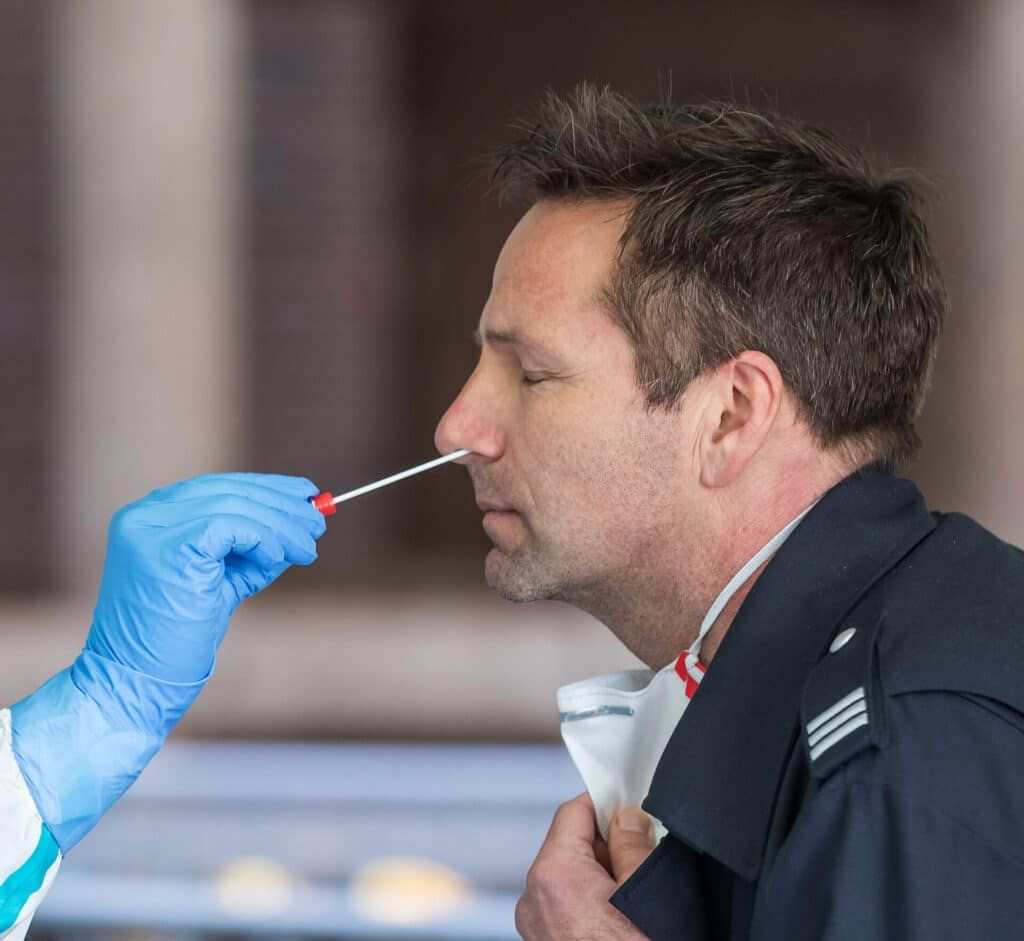How to minimize COVID’s impacts once the federal emergency “ends”
By Lynn Klotz, Jonas Sandbrink | March 2, 2023
 A COVID test. Credit: Raimond Spekking. CC BY-SA 4.0 via Wikimedia.
A COVID test. Credit: Raimond Spekking. CC BY-SA 4.0 via Wikimedia.
President Joe Biden’s administration announced that come May 11, COVID-19 will no longer be a public health emergency necessitating special governmental powers. Republicans in the House passed a bill to end the emergency immediately. And Biden himself famously declared the pandemic over at an auto show in September. Of course, no matter how many federal officials make pronouncements, the COVID-19 pandemic won’t be over any time soon. Trevor Bedford, a computational virologist at the Fred Hutchinson Cancer Center in Seattle, told David Wallace-Wells of The New York Times that each year about 50 percent of Americans will get COVID-19 and 100,000 will die. The article was appropriately titled “Endemic Covid-19 Looks Pretty Brutal.” It will be, and society should be prepared to limit the carnage with better medicines, better vaccines, and better air filtration systems.
The ever-renewing emergence of subvariants of the highly transmissible omicron strain is sustaining high infection numbers in the United States. As recently as mid-November, the BA.5 and BA.4.6 subvariants comprised close to 40 percent of infections, according to a CDC estimate. Now, just a few months later, both have essentially disappeared. Those once threatening viruses have been replaced by a host of more contagious subvariants, like XBB.1.5, which constituted 80 percent of infections on February 18.
Bedford’s estimate of 100,000 American deaths per year from COVID-19 would hold up if deaths continued at recent levels. From May to December 2022, deaths averaged about 2,700 per week. We might expect then that COVID-19 deaths over 52 weeks would number about 140,000 for a given year. (Death rates would vary, naturally, with how severe a particular viral strain is and other factors.)
At this level, COVID-19 would be the third leading cause of deaths from disease in the United States, exceeded only by heart disease and cancer. And it would far outrank other diseases and lethal phenomena.
There were 45,222 firearm deaths in the United States in 2020, more than 42,000 people were killed in 2021 in auto accidents, and Americans suffered between 5,000 and 52,000 deaths annually in recent years from seasonal influenza.
And death, of course, isn’t the only bad or costly possible outcome of a COVID-19 infection. On any given day, tens of thousands of patients are in the hospital in the United States. Omicron and its multitude of descendants also likely come with substantial economic burdens. These should inspire ambitious interventions. Infections, hospitalizations, and deaths could cost the United States a minimum of $18 billion per year, according to an analysis by one of us (Klotz). This takes into account direct costs associated with illness and death. Another recent study uses a broader range of costs to conclude that the million deaths between February 2020 and May 2022 contributed to “economic welfare losses estimated in terms of national income growth supplemented by the value of lives lost … in the order of [$3.57] trillion.”
So what can be done to reduce this unacceptable number of hospitalizations and deaths and reduce the impact of COVID-19 on the economy? Promising therapies and interventions exist. The question is whether there is the societal will to enact them.
William Hanage, a professor of epidemiology at Harvard told the Boston Globe that “[w]e can see that there is some immunity out there, and it is interfering with the transmission of the virus. It’s just not interfering with the transmission of the virus to make it go away.” Those previously infected, cured persons are protected from reinfection by antibodies for a few months and by immune system T- and B-cells for up to a year or more. Vaccinations over the past year also contribute to this background immunity. Together, natural and vaccine-induced immunity will slow transmission. However, given that immune responses wane and ever-new immune-evasive subvariants are rising, transmission cannot be expected to go to zero.
New tools to enhance immunity could help reduce transmission. One of the most promising is the idea of nasal vaccines that elicit mucosal immunity. The current vaccines from Moderna, Pfizer, and several other producers elicits what’s called systemic immunity against COVID-19 throughout our body, creating so-called immunoglobulin G (IgG) antibodies. These can neutralize the virus as it courses through the body. Yet it is in the mucus membranes, the linings of the nose, mouth, and lungs, where people first encounter COVID-19 variants. Another type of immunity called mucosal immunity can prevent the virus (and other respiratory pathogens) from sparking an infection in the first place. In response to pathogens, the mucosal immune system protects us by making antibodies known as immunoglobulin A (IgA).
The Yale University immunologist Akiko Iwasaki argued in Scientific American, “If we want to contain the spread of the virus, the only way to do that is through mucosal immunity” using nasal vaccines. The “mucosal vaccines [are like] putting a guard at the front door, as opposed to waiting until the invader is already inside to attack,” she said. The good news is that there are a lot of nasal vaccine candidates—out of 100 oral or nasal candidates being developed globally, about 20 have made it to human trials, according to Nature. The bad news is that enthusiasm and funding for building on one of the successes of the COVID-19 era, the Operation Warp Speed vaccine program, has waned. While other countries are barreling ahead to produce next generation vaccines, the United States is not. “It went back to the pre-pandemic speed of vaccine development,” Florian Krammer, a virologist at the Icahn School of Medicine at Mount Sinai, told The New York Times last November.
In two to four years, nasal vaccines could play an important role in preventing the spread of COVID-19, but many strategies may be necessary to eliminate the virus or make it harmless.
Another way to reduce the burden of COVID-19 would be to improve air quality. “Public health policy makers need to adopt the air bag model for COVID—safety measures that work in the background without individuals needing to take initiative to get substantial benefit,” Ezekiel J. Emanual, a medical doctor and ethicist, wrote in the Boston Globe. Even when high levels of virus transmission are occurring, closing all public venues is not practical, for economic and political reasons. Cleaning the air in these places is the better option.
HEPA-filtered air, as provided in airplanes or hospitals, can dramatically improve air quality. Another approach—pending more safety and efficacy data –could be to disinfect the air with low wavelength far-UVC light, which cannot pass through the outermost layer of human skin but can readily inactivate airborne microbes. The Infrastructure Investment and Jobs Act, passed in November of 2021, could be one area for funding the necessary infrastructure improvements. The law provides financing for improving air quality in public places, but it will likely take a year or two for the money to filter down to communities.
Another question is how to effectively continue activities with well-established public-health benefits, like masking indoors and in outdoor crowds. Despite how politically contentious masking has become, masks can be extremely effective.
In universally masked settings, transmission was low even with reduced social distancing.
At Boston University, as students returned to in-person classes in 2021, they were required to be vaccinated and to wear masks inside. A study found just 9 cases of in-class transmission between Sept. 1 and Dec. 1, 2021, a time when COVID-19 was circulating in the surrounding communities. Likewise, a large study involving over one million students and staff in kindergarten through 12th grade revealed low rates of in-school transmission between mid-March and late June in 2021. There was one school acquired infection for every 20 in the community, the study published in American Academy of Pediatrics in 2022 found.
But even if masking is effective, skeptics will point out that many people in the United States are unmasked in public and will likely not change their behavior.
In addition to measures to reduce transmission, medicines are a crucial strategy to manage the toll of future COVID variants. There are therapies on the market and several in development.
Pfizer’s Paxlovid is the go-to drug for the treatment of mild-to-moderate omicron subvariant infections. There are several new medicines, as well. Harvard researchers announced an antibody treatment that works against all variants. (Other antibody treatments have had to be discontinued after the virus had mutated to thwart them.)
This new treatment should be able to fight off any viral variant that might emerge. The findings were published in Science Immunology last August. The drug works by blocking the fusion of the outer membrane of the virus with the membrane of our cells. The fusion site is highly conserved among different omicron subvariants, implying that fusion in future variants should also be blocked. Indeed, the antibody neutralized all omicron subvariants in lab tests. So far, it has not been tested in humans. If successful in humans and eventually approved by the FDA, this could be the miracle medicine we have all been hoping for.
Some strategies, like better medicines, will allow us to survive COVID. Others, like better vaccines and better air, could help quash outbreaks. Only time will tell if we will be able to ever rid ourselves of omicron and its subvariants. Others infectious disease threats could be looming, as well. H5N1 bird flu recently swept through a mink farm in Spain, raising concerns that the virus could mutate so it transmits more easily among mammals, including humans. That would be a potentially catastrophic development. The virus kills 50 percent of the people it infects. Far from being important only for taming COVID-19, new vaccines, therapies, and technologies may one day, unfortunately, be needed to thwart H5N1, too.
Together, we make the world safer.
The Bulletin elevates expert voices above the noise. But as an independent nonprofit organization, our operations depend on the support of readers like you. Help us continue to deliver quality journalism that holds leaders accountable. Your support of our work at any level is important. In return, we promise our coverage will be understandable, influential, vigilant, solution-oriented, and fair-minded. Together we can make a difference.
Keywords: COVID-19, H5N1
Topics: Biosecurity

















Mr Klotz, I will never forget your warning of October 20, 2014 . TODAY WE ARE ASKED TO BELIEVE COVID19 was not, at best, a lab escape. Could you comment in now in 2023 on the warning you had made. Since today, Rand Paul and Anthony Fauci are debating on the definition of ”Gain of Function” used for the creation of Potential Pandemic Pathogens. Thanks in advance for your comments. My email address is [email protected] ____________________________ CENTER FOR ARMS CONTROL AND NON-PROLIFERATION BIOLOGICAL AND CHEMICAL WEAPONS CONTROL PROGRAM Written comments in advance of the NSABB meeting on October 22, 2014… Read more »
Great article. A few comments: (1) Reusable P100 elastomeric respirator masks (like the 3M 6300). These would make healthcare safe. Hospitals which have adopted them find the staff are very happy with them (Texas Center for Infectious Disease is one, Alleghany Health System is another) (2) Studies show that comprehensive use of N99/ FFP3 or P100 masks would end transmission in pretty much any environment… a Cambridge hospital study is the strongest proof of this. (3) Studies also show that comprehensive use of HEPA filters ends transmission except in close face-to-face contact. A *restaurant*, Apricot Tree Cafe in Mississaugua (Ontario),… Read more »